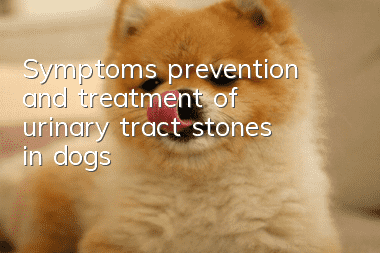Symptoms, prevention and treatment of urinary tract stones in dogs

Urinary tract diseases are relatively common diseases for older cats and dogs. If you pay attention to the adjustment of diet and living habits when you are young, most of them can be avoided. However, scientific research on pets has only been mentioned in recent years. It’s on the agenda, so when our beloved cats or dogs suffer from urinary system diseases, we can only take active and correct treatment measures to alleviate the little guys’ pain. So what are the symptoms of urinary tract stones in dogs, and how to prevent and treat them?
Symptoms of urinary tract stones in dogs:
1. Bladder stones: difficulty urinating, hematuria, and frequent urination, but the dog only excretes a small amount of urine each time. During bladder palpation, multiple stones may be felt rubbing against each other or hard bladder stones may be palpated. When cystitis is complicated, it can be reflected by urinalysis. Abnormal findings include an increase in white blood cells, red blood cells, proteinuria, etc., the pH value is often elevated, and the urine contains a large number of bacteria.
2. Urethral calculus is a complication of bladder skin calculus. The sick dog has difficulty in urinating frequently, but only a small amount of hematuria is excreted or there is no urine at all. The sick dog is restless, forced to walk, and painful. There is severe pain in the bladder when palpating the posterior abdomen. Long-term urinary anemia can cause uremia. Symptoms include depression, vomiting, ammonia smell in exhaled breath, scleral congestion, dehydration, increased urea nitrogen and creatine content in the blood, extreme bladder expansion, and severe loss of elasticity, which may lead to bladder rupture.
X-ray photography is of great diagnostic value for urinary system diseases caused by stones.
Treatment of urinary tract stones in dogs:
If bladder stones have shown clinical symptoms, surgical incision of the bladder to remove the stones should be considered.
For urethral stones, retrograde urethral flushing can be performed, inserting a urethral catheter into the urethra, and injecting urethral flushing fluid or an equal mixture of normal saline and liquid paraffin while compressing the urethra at the pelvic edge. When the urethral pressure increases, quickly release and withdraw the urinary catheter, which can be repeated several times. Until the stones are flushed out and retrograde flushing is unsuccessful, urethrotomy should be performed as soon as possible to remove the urethral stones.
Prevention of urinary tract stones in dogs:
1. Always feed more water!!
2. Usually, half dog food and half dog rice are used. Dog food is diversified. Dog food must have a formula to prevent urinary system diseases.
3. Dog rice is also diverse, especially not just fish, but also omnivores such as chicken, duck, fish, pig, beef, mutton, vegetables, and grains.
4. Frequently feed acidic things such as Vc.
5. Eat canned formula often.
- Causes of lead poisoning in dogs | Diagnosis | Prevention and treatment methods
- Causes of excessive eye mucus in Huskies
- Should dogs be neutered or not?
- What should I do if my dog is disobedient when he goes out and the owner can’t come back when called?
- Is it useful to vaccinate dogs against rabies?
- What should you pay attention to when raising a bulldog?
- Corgi neutering time
- Common knowledge about dog eye diseases and 6 major signs of illness caused by eye abnormalities!
- Can dogs use shower gel when bathing?
- Why does the dog keep barking in the middle of the night?



